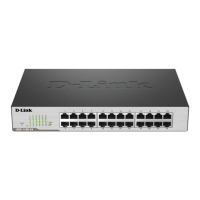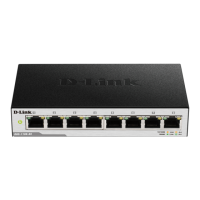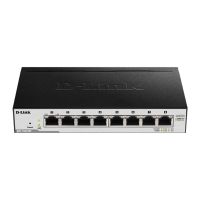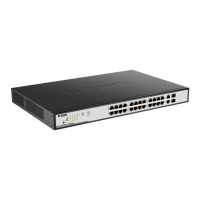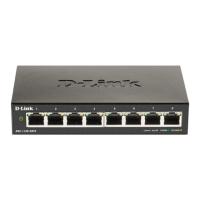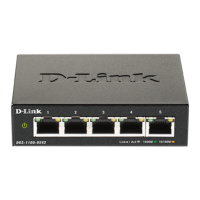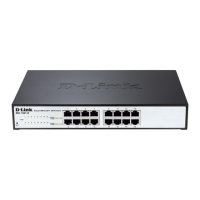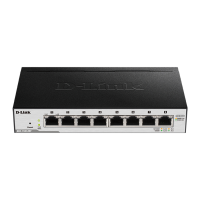Do you have a question about the D-Link DGS-1100-10MP and is the answer not in the manual?
Identifies the intended audience for this manual, typically network administrators and IT professionals.
Explains the two distinct operating modes of the switch's web interface: Standard and Surveillance.
Lists additional resources and guides available for configuring and troubleshooting the switch.
Defines the typographical and formatting conventions used throughout the manual for clarity.
Highlights important information, potential hardware damage, or safety warnings using specific indicators.
Details the front and rear panel features, LEDs, and ports of the DGS-1100-10MP model.
Details the front and rear panel features, LEDs, and ports of the DGS-1100-10MPP model.
Details the front and rear panel features, LEDs, and ports of the DGS-1100-26MP model.
Details the front and rear panel features, LEDs, and ports of the DGS-1100-26MPP model.
Guides users through the process of unpacking the switch and checking its contents.
Details methods for installing the switch on a desktop, shelf, or in a rack, including safety precautions.
Provides instructions for connecting the switch to an electrical outlet.
Explains the procedure for properly grounding the switch for safety and operational integrity.
Outlines the available platforms for managing the switch: Web UI, SNMP, and D-Link Network Assistant.
Details on connecting to, logging into, and navigating the switch's web interface, including Smart Wizard.
Presents a visual diagram of the surveillance network, showing connected devices and their status.
Provides detailed information on the switch's hardware, network settings, firmware versions, and system uptime.
Overview of port status, throughput, PoE status, cable length, and connected devices for each port.
Lists and details recognized devices connected to specific ports, including their group number and type.
Displays information for each connected IP camera, including port, type, throughput, IP address, and description.
Displays information for each connected NVR and its managed IP cameras, including group name and IP addresses.
Provides details on power over Ethernet usage, status, budget, and consumption per port.
Configures time-based schedules for PoE power delivery to ports, allowing power saving and security.
Manually configure the switch's system time and date for accurate logging and operations.
Configure an external time source for automatic clock synchronization, ensuring accurate timekeeping.
Configure Surveillance VLAN ID, IP settings, netmask, and gateway for dedicated surveillance traffic.
Configure SNMP host, log server, and password settings for network management and security.
Define uplink ports for connecting to other switches or network segments for surveillance VLAN traffic.
View, refresh, and back up system logs (Syslog messages) for troubleshooting and monitoring.
Overview of port status, including loopback detection, cable link, PoE status, errors, and connected devices.
Information, upgrade, and backup procedures for switch firmware, including HTTP transfer.
Restore and backup switch configuration files from a local PC via HTTP for disaster recovery.
Procedures for resetting the switch to factory defaults and rebooting the system with or without saving settings.
Explanation of Gigabit Ethernet standards, its benefits, and its role in modern networking.
Explanation of Fast Ethernet standards, its evolution from 10BASE-T, and its advantages.
Description of network switching principles and how it increases network capacity and efficiency.
Details on switching capacity, forwarding rates, buffer memory, port functions, and flash memory.
Operating temperature, humidity, power input, and acoustic values for the switch.
Lists regulatory certifications related to electromagnetic interference (EMI).
Lists safety certifications such as CUL, LVD, CB, BSMI, ensuring compliance with safety standards.
Summary of Layer 2 features, multicast, VLAN, QoS, security, management, power saving, and surge protection.
Critical safety considerations for installing equipment in racks, including ambient temperature and airflow.
Identifies the intended audience for this manual, typically network administrators and IT professionals.
Explains the two distinct operating modes of the switch's web interface: Standard and Surveillance.
Lists additional resources and guides available for configuring and troubleshooting the switch.
Defines the typographical and formatting conventions used throughout the manual for clarity.
Highlights important information, potential hardware damage, or safety warnings using specific indicators.
Details the front and rear panel features, LEDs, and ports of the DGS-1100-10MP model.
Details the front and rear panel features, LEDs, and ports of the DGS-1100-10MPP model.
Details the front and rear panel features, LEDs, and ports of the DGS-1100-26MP model.
Details the front and rear panel features, LEDs, and ports of the DGS-1100-26MPP model.
Guides users through the process of unpacking the switch and checking its contents.
Details methods for installing the switch on a desktop, shelf, or in a rack, including safety precautions.
Provides instructions for connecting the switch to an electrical outlet.
Explains the procedure for properly grounding the switch for safety and operational integrity.
Outlines the available platforms for managing the switch: Web UI, SNMP, and D-Link Network Assistant.
Details on connecting to, logging into, and navigating the switch's web interface, including Smart Wizard.
Presents a visual diagram of the surveillance network, showing connected devices and their status.
Provides detailed information on the switch's hardware, network settings, firmware versions, and system uptime.
Overview of port status, throughput, PoE status, cable length, and connected devices for each port.
Lists and details recognized devices connected to specific ports, including their group number and type.
Displays information for each connected IP camera, including port, type, throughput, IP address, and description.
Displays information for each connected NVR and its managed IP cameras, including group name and IP addresses.
Provides details on power over Ethernet usage, status, budget, and consumption per port.
Configures time-based schedules for PoE power delivery to ports, allowing power saving and security.
Manually configure the switch's system time and date for accurate logging and operations.
Configure an external time source for automatic clock synchronization, ensuring accurate timekeeping.
Configure Surveillance VLAN ID, IP settings, netmask, and gateway for dedicated surveillance traffic.
Configure SNMP host, log server, and password settings for network management and security.
Define uplink ports for connecting to other switches or network segments for surveillance VLAN traffic.
View, refresh, and back up system logs (Syslog messages) for troubleshooting and monitoring.
Overview of port status, including loopback detection, cable link, PoE status, errors, and connected devices.
Information, upgrade, and backup procedures for switch firmware, including HTTP transfer.
Restore and backup switch configuration files from a local PC via HTTP for disaster recovery.
Procedures for resetting the switch to factory defaults and rebooting the system with or without saving settings.
Explanation of Gigabit Ethernet standards, its benefits, and its role in modern networking.
Explanation of Fast Ethernet standards, its evolution from 10BASE-T, and its advantages.
Description of network switching principles and how it increases network capacity and efficiency.
Details on switching capacity, forwarding rates, buffer memory, port functions, and flash memory.
Operating temperature, humidity, power input, and acoustic values for the switch.
Lists regulatory certifications related to electromagnetic interference (EMI).
Lists safety certifications such as CUL, LVD, CB, BSMI, ensuring compliance with safety standards.
Summary of Layer 2 features, multicast, VLAN, QoS, security, management, power saving, and surge protection.
Critical safety considerations for installing equipment in racks, including ambient temperature and airflow.
